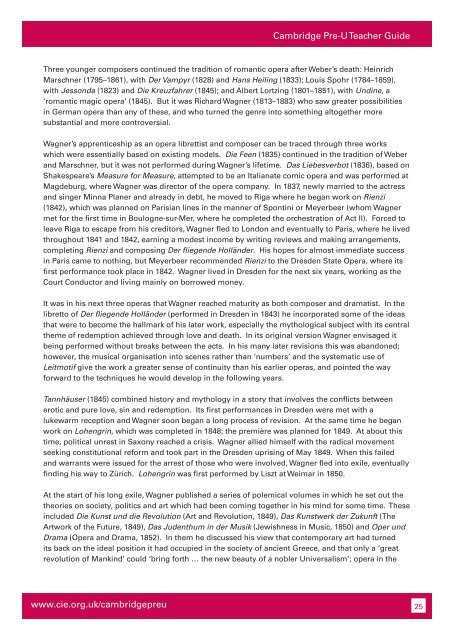Teacher's Guide Cambridge Pre-U MUSIC Available for teaching ...
Teacher's Guide Cambridge Pre-U MUSIC Available for teaching ...
Teacher's Guide Cambridge Pre-U MUSIC Available for teaching ...
You also want an ePaper? Increase the reach of your titles
YUMPU automatically turns print PDFs into web optimized ePapers that Google loves.
<strong>Cambridge</strong> <strong>Pre</strong>-U Teacher <strong>Guide</strong><br />
Three younger composers continued the tradition of romantic opera after Weber’s death: Heinrich<br />
Marschner (1795–1861), with Der Vampyr (1828) and Hans Heiling (1833); Louis Spohr (1784–1859),<br />
with Jessonda (1823) and Die Kreuzfahrer (1845); and Albert Lortzing (1801–1851), with Undine, a<br />
‘romantic magic opera’ (1845). But it was Richard Wagner (1813–1883) who saw greater possibilities<br />
in German opera than any of these, and who turned the genre into something altogether more<br />
substantial and more controversial.<br />
Wagner’s apprenticeship as an opera librettist and composer can be traced through three works<br />
which were essentially based on existing models. Die Feen (1835) continued in the tradition of Weber<br />
and Marschner, but it was not per<strong>for</strong>med during Wagner’s lifetime. Das Liebesverbot (1836), based on<br />
Shakespeare’s Measure <strong>for</strong> Measure, attempted to be an Italianate comic opera and was per<strong>for</strong>med at<br />
Magdeburg, where Wagner was director of the opera company. In 1837, newly married to the actress<br />
and singer Minna Planer and already in debt, he moved to Riga where he began work on Rienzi<br />
(1842), which was planned on Parisian lines in the manner of Spontini or Meyerbeer (whom Wagner<br />
met <strong>for</strong> the first time in Boulogne-sur-Mer, where he completed the orchestration of Act II). Forced to<br />
leave Riga to escape from his creditors, Wagner fled to London and eventually to Paris, where he lived<br />
throughout 1841 and 1842, earning a modest income by writing reviews and making arrangements,<br />
completing Rienzi and composing Der fliegende Holländer. His hopes <strong>for</strong> almost immediate success<br />
in Paris came to nothing, but Meyerbeer recommended Rienzi to the Dresden State Opera, where its<br />
first per<strong>for</strong>mance took place in 1842. Wagner lived in Dresden <strong>for</strong> the next six years, working as the<br />
Court Conductor and living mainly on borrowed money.<br />
It was in his next three operas that Wagner reached maturity as both composer and dramatist. In the<br />
libretto of Der fliegende Holländer (per<strong>for</strong>med in Dresden in 1843) he incorporated some of the ideas<br />
that were to become the hallmark of his later work, especially the mythological subject with its central<br />
theme of redemption achieved through love and death. In its original version Wagner envisaged it<br />
being per<strong>for</strong>med without breaks between the acts. In his many later revisions this was abandoned;<br />
however, the musical organisation into scenes rather than ‘numbers’ and the systematic use of<br />
Leitmotif give the work a greater sense of continuity than his earlier operas, and pointed the way<br />
<strong>for</strong>ward to the techniques he would develop in the following years.<br />
Tannhäuser (1845) combined history and mythology in a story that involves the conflicts between<br />
erotic and pure love, sin and redemption. Its first per<strong>for</strong>mances in Dresden were met with a<br />
lukewarm reception and Wagner soon began a long process of revision. At the same time he began<br />
work on Lohengrin, which was completed in 1848; the première was planned <strong>for</strong> 1849. At about this<br />
time, political unrest in Saxony reached a crisis. Wagner allied himself with the radical movement<br />
seeking constitutional re<strong>for</strong>m and took part in the Dresden uprising of May 1849. When this failed<br />
and warrants were issued <strong>for</strong> the arrest of those who were involved, Wagner fled into exile, eventually<br />
finding his way to Zürich. Lohengrin was first per<strong>for</strong>med by Liszt at Weimar in 1850.<br />
At the start of his long exile, Wagner published a series of polemical volumes in which he set out the<br />
theories on society, politics and art which had been coming together in his mind <strong>for</strong> some time. These<br />
included Die Kunst und die Revolution (Art and Revolution, 1849), Das Kunstwerk der Zukunft (The<br />
Artwork of the Future, 1849), Das Judenthum in der Musik (Jewishness in Music, 1850) and Oper und<br />
Drama (Opera and Drama, 1852). In them he discussed his view that contemporary art had turned<br />
its back on the ideal position it had occupied in the society of ancient Greece, and that only a ‘great<br />
revolution of Mankind’ could ‘bring <strong>for</strong>th … the new beauty of a nobler Universalism’; opera in the<br />
www.cie.org.uk/cambridgepreu 25
















